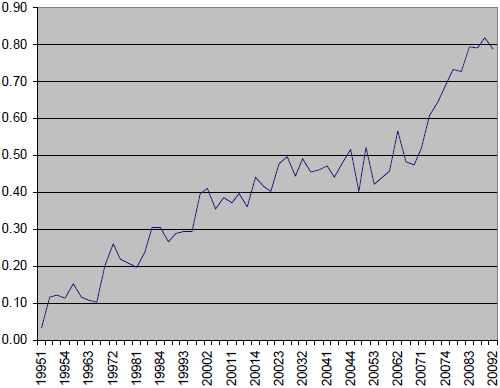Does high-frequency trading amplify noise and thereby reduce the signal-to-noise ratio in stock returns? In his August 2010 paper entitled “The Effect of High-Frequency Trading on Stock Volatility and Price Discovery”, Frank Zhang examines the effect of high-frequency trading on stock price volatility and on incorporation of fundamental news into price. He defines high-frequency trading as that driven by fully automated trading strategies with very high trading volume and extremely short holding periods ranging from milliseconds to minutes and possibly hours (typically not overnight). He estimates the volume of high-frequency trading as the residual after accounting for institutional and individual investor activities. Using price, trading and institutional holdings data for a broad sample of U.S. stocks from the first quarter of 1985 through the second quarter of 2009, he finds that:
- High-frequency trading has rapidly become the dominant trading mechanism in the U.S. equity market capital market, growing from near zero in 1995 to about 78% of dollar trading volume in the first half of 2009, far exceeding market liquidity needs.
- Market-wide quarterly stock turnover (trading volume divided by outstanding shares) is fairly stable at around 17% for 1985 through 1994 and then increases rapidly to 115% in 2008.
- High-frequency trading relates positively to stock price volatility after controlling for volatility driven by fundamental news and external factors. The positive correlation is stronger for the 3,000 stocks with the highest market capitalizations and for stocks with high institutional holdings. The positive correlation is also stronger during periods of high market uncertainty.
- High-frequency trading causes stock prices to overreact to fundamental news, with associated incremental price reactions subsequently reversing almost entirely.
The following chart, taken from the paper, plots the estimated dollar volume of high-frequency trading (the residual after accounting for institutional and individual investor trading) as a percentage of total dollar trading volume from the first quarter of 1995 through the second quarter of 2009. The chart shows the rapid ascent of this automated, very short-term trading to a dominant role in the U.S. equities market.

In summary, evidence suggests that dramatic growth in high-frequency trading in recent years constitutes a structural change in financial markets characterized by elevated volatilities and overreactions to news.
These effects may compound the asset and asset class volatility synchronizations described in “Effects of Creeping Indexation”, making it even more difficult to relate price to fundamental valuation metrics and materially confounding portfolio allocations (such as those derived via Modern Portfolio Theory) based on data generated before high-frequency trading became dominant.